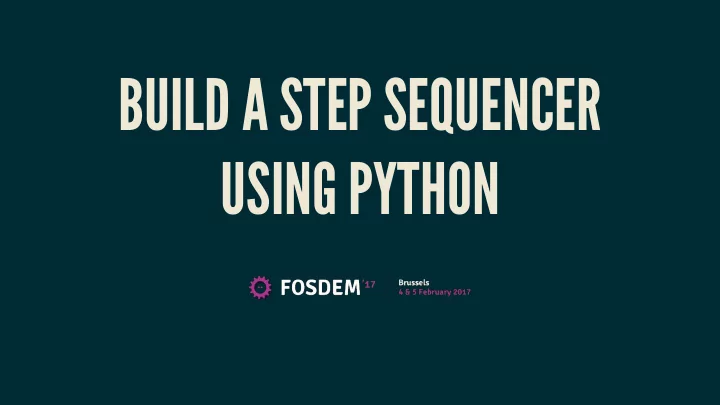

BUILD A STEP SEQUENCER USING PYTHON
WHO AM I? Yann Gravrand (@ygravrand) Techie Musician
PART 1: BACKGROUND Musical instruments Synthetizers and samplers Sequencers Step sequencers
MUSICAL INSTRUMENTS Can be played by humans uk.funzing.com Some can be "played" by computers: Synthetizers Samplers ...
SYNTHETIZERS Sound generators Lots of parameters can be tweaked
FAMOUS SYNTHETIZERS Minimoog (analog) DX7 (digital)
FAMOUS SYNTHETIZERS Nord Lead (analog modeling) Mininova (analog modeling)
VST VST Plugins
SAMPLERS Do not generate sounds themselves Play samples (little chunks of sound)
SAMPLES / NOTES: One sample for the whole keyboard (pitch adjusted or not)
One sample for each note
One sample for a group of notes, pitch is ajusted
DRUM MACHINES? Sound generator (drum oriented) + step sequencer TR 909 Tempest
SEQUENCERS Play a sequence of notes Several tracks, instruments...
STEP SEQUENCER A 4/4 measure is divided into: 4 quarter notes Each quarter note is divided into 4 steps --> A sequence like this is 16 steps long
STEP SEQUENCER For each step, we define: the note / pitch other attributes: length... ... and activate it or not
EXAMPLES Daft punk - Aerodynamic @ 1:03 4 * 16-step patterns
EXAMPLES Daft punk - Aerodynamic @ 2:28 4 * 16-step patterns, some notes off
USING A STEP SEQUENCER "Step by step" mode: for each step, define the note attributes. No timing, no rush "Live" mode: turn steps on and off in real time, adjust pitch, length...
PART 2: THE PROJECT Project goals MIDI Using mido The Dirty Part: blocking, threads, asyncio...
I HAD A cool synth Colorful (and empty) pads
AND A snake
PROJECT GOALS Make the synthetizer play notes using Python Modify and turn notes on / off to create a sequence Implement "step by step" and "live" modes Change tempo in real time Make interactions possible with any controller... ... Starting with mine, of course :) No GUI, focus on usability with hardware (live oriented)
MIDI: MUSICAL INSTRUMENT DIGITAL INTERFACE Extremely old standard: 1983! Still largely in use today To synchronize and communicate between devices Message types: Notes (NOTE ON, NOTE OFF) Control Change (Ex: Filter resonance, Hold pedal...) Program Change (Change instrument) Sys ex ...
WE WILL NEED TO SPEAK MIDI WITH DEVICES Midi input: pads pressed, keys pressed, knobs turned... Midi output: play a note, turn a LED on...
MIDI INPUT: RECEIVING MESSAGES inport = mido.open_input() msg = inport.receive() # Blocking call Message reception blocks So if we want to do something else in parallel, we have to handle this in a thread or coroutine or...?
MIDI OUTPUT: PLAYING NOTES import mido outport = mido.open_output() msg = mido.Message('note_on', note=100, velocity=3) outport.send(msg) --> BEEEEEEEEEEEEEEEEEEEE... outport.send(mido.Message('note_off', note=100)) --> ... EEEP. To play notes, we need a timer between NOTE_ON and NOTE_OFF (note duration). time.sleep ?
ALIGNING NOTES (STEPS) WITH TEMPO Naive implementation: while True: outport.send(mido.Message(...)) time.sleep(tempo.step_duration) Two problems: time.sleep also blocks, so we have to handle it in a thread or coroutine or... Waking up, sleeping for X seconds, waking up...: the tempo slowly drifts. Calculate absolute times
SOLUTIONS Threads Many queues to avoid shared state Coroutines with asyncio Everything in a single thread, less concurrency issues Ok since our app is I/O bound ...But we have to modify mido to insert yield from or await ... Greenlets with gevent Monkey patches time.sleep so we can use mido as is and have greenlets
PROPOSED DESIGN Main process is I/O bound Console process is CPU bound!
PART 3: IMPLEMENTATION & DEMO System overview Implementing a controller Action!
SYSTEM OVERVIEW
IMPLEMENTING A CONTROLLER Map messages from controller (pad pressed) to sequencer actions (toggle step) Send messages to controller for feedback (LEDs...)
INTERPRETING EVENTS FROM CONTROLLERS Some events are represented by a single message Others are the result of a sequence of messages (ex: NPRN LSB, MSB) Solution: a RulesChain Each Rule matches a message A state automaton keeps track of the matched rules Flexible rules evaluation engine self.register('FILTER', self.on_cc, RulesChain(Rule(type_='control_change', control='74'), Rule(type_='control_change', control='27', value='0')) )
REACTING TO SEQUENCER EVENTS self.sequencer.on(SequencerEvents.STEP_BEGIN, self, self.on_step_begin) ... def on_step_begin(self, step): # Turn on current step LED self.sequencer.output(self, *msb_lsb_output(60, 0, 32 + step.pos))
IN ACTION!
IN ACTION! Bass pattern Drum pattern 1 Drum pattern 2 Mozart pattern (32-step sequence) Daft punk - da funk Remote console
WHY PYTHON? BENEFITS Easy to read, easy to write The dynamic features of Python and plugin system make writing controllers easy! Large ecosystem
CHALLENGES Python is not the best choice for real-time computing Performance on tiny devices (C.H.I.P, Rpi...) Steppy was designed with simplicity in mind (gevent / single thread execution model) Implies we must be "green" and use the least CPU possible
WHERE IS MY CPU? Rules evaluation engine: Speed can be improved: PyPy, Cython, Numba...? Pretty printing (large characters): Isolate on a core Move the problem - using Websockets!
FUTURE PLANS Chords (especially important for a drum machine...) Multi track Load / save to midi External tempo sync Better reactive Web interface Web interface for rules config (like Live's mappings) Other protocols: DMX...
THANK YOU! @ygravrand github.com/ygravrand/steppy
Recommend
More recommend